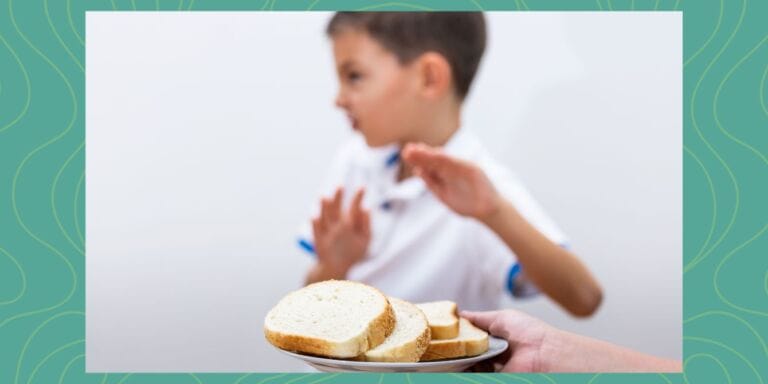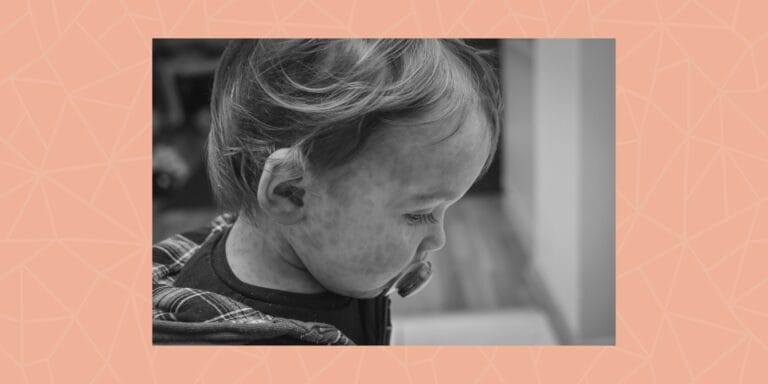Spotting the signs of eating disorders in kids and teens

Gillian Vann/Stocksy
More children and teens than ever are struggling with eating disorders and disordered eating. An expert shares what to know.

Table of Contents
The number of children struggling with eating disorders is more significant than many people realize. In fact, a 2023 study by JAMA Pediatrics found that 1 in 5 kids globally have disordered eating. Additionally, in 2019, almost 3 million children and adolescents experienced eating disorders. As disordered eating and eating disorders become more prevalent in kids under 17, it is critical for parents to be aware of early warning signs, symptoms and treatment options. Here’s what to look for.
Eating disorders vs disordered eating
Eating disorders are serious mental health conditions characterized by significant disturbances in eating behaviors, cognitions and emotions. They are life-threatening illnesses and have one of the highest mortality rates of any psychiatric disorder. People with eating disorders experience extreme fixation with food and body image disturbance.
It is crucial to recognize that eating disorders and disordered eating differ significantly in nature and severity. While eating disorders pose grave risks to one’s mental health and disrupt their eating patterns and relationship with food, disordered eating refers to a broader spectrum of unhealthy eating behaviors. Although individuals struggling with disordered eating also face challenges in their relationship to food, their behaviors are generally less severe and do not meet the diagnostic criteria of eating disorders as defined in the DSM-5.
However, it is also very common in our society to struggle with disordered eating and body image concerns. Although eating disorders are complex biopsychosocial illnesses, all of us are bombarded with societal messages conveying a preference for thin bodies, messages promoting dieting, and fat phobia.
Sadly, school-based studies have indicated that as many as 20% to 56% of kids ages 8 to 13 report dieting. So, while not everyone’s struggles with food meet the threshold of being a diagnosable eating disorder, these experiences can significantly impact quality of life, self-esteem and health outcomes.
The good news is that eating disorders are treatable and there are many helpful resources available for parents. But early intervention is key. If you are concerned that your child may have an eating disorder, or if they are displaying signs of disordered eating, it is imperative to act early to reduce the likelihood of potential harm and support healthy physical and emotional growth.
Who is affected by eating disorders?
Anyone can develop an eating disorder, but eating disorders disproportionately affect LGBTQIA+ youth, with as many as 29% of adolescents ages 13 to 24 reporting symptoms of an eating disorder, compared to about 4% of straight teens.
Trans and non-binary youth are at even higher risk for developing an eating disorder sometimes due, in part, to attempts to manage their gender dysphoria.
BIPOC youth are also at risk for eating disorders and are less likely to be identified. This can subsequently delay treatment and lead to complicated mental and physical health consequences.
As disordered eating and eating disorders become more prevalent in children, it is critical for parents to be aware of early warning signs, symptoms, and treatment options.
Early signs of eating disorders in kids
Early intervention plays a pivotal role in developing a successful treatment plan for eating disorders. Adolescents and teenagers struggling with these disorders often try to hide their symptoms, but there are numerous warning signs that parents should be aware of.
These red flags include restricted food choices, wearing loose-fitting clothing, negative body comments, categorizing foods as “good” or “bad” and eliminating entire food groups, mentioning being on a diet, attempts to skip meals, and immediately heading to the bathroom after eating. Recognizing these early signs is crucial for timely intervention and effective treatment.
Physical signs of eating disorders in children, tweens and teens
Physical symptoms of eating disorders in kids and teens can range from mild to severe.
Mild symptoms can include:
- Hair loss
- Muscle weakness
- Swollen glands
- Fatigue
- Cold intolerance
Serious symptoms include:
- Very low heart rate
- Electrolyte imbalance
- Osteopenia
- Heart damage
Malnutrition is a significant concern associated with several types of eating disorders and can stunt physical development, including brain, bone and heart development. If your adolescent stops getting their menstrual cycle for more than 3 months, it can be a sign of an underlying medical issue.
Behavioral signs of eating disorders in children, tweens and teens
You may notice behavioral signs of an eating disorder before physical signs are evident.
Examples of behavioral signs of eating disorders:
- Altered eating patterns or skipping meals
- May express body image concerns
- May appear preoccupied with food or diets
Older teens may experiment with compulsive exercising, taking laxatives or diet pills, vomiting after eating, hiding food, engaging in binge eating or chewing and spitting out their food.
If you notice any of these symptoms, please consider getting your child help. Intervening before an eating disorder is fully entrenched can give kids their best shot at a quick and full recovery. Eating disorders require treatment by a multidisciplinary team of providers including a medical provider, a therapist and a dietitian.
Beyond picky eating: What to know about ARFID
Children are being diagnosed with eating disorders earlier than ever before, with children as young as 6 years old developing dangerous eating disorder symptoms. Avoidant/restrictive food intake disorder (ARFID) is one example of an eating disorder that is common in younger children.
Children with ARFID can display extremely selective eating behaviors, can have little interest in eating, or may experience an intense fear of choking or vomiting. They may eat a limited variety of preferred foods, which can hinder their growth and lead to poor nutrition.
Whenever a child begins to cut out food groups or significantly limit their variety of food choices, parents should seek help from treatment providers. Although sometimes children outgrow “picky eating”, ARFID is a much more serious concern.
What parents can do
As a parent, the way you model your relationship with food and body can have a profound impact on your children. Children are highly impressionable and intuitive and will absorb parental behaviors and attitudes.
Conversations should avoid “good and bad” food talk, an emphasis on weight, endorsements of dieting, or statements about exercising to “burn off” calories. Because eating disorders are complex psychosocial illnesses, it’s important that you don’t blame yourself if your child develops an eating disorder. However, it’s vital that we collectively work to create a culture where eating disorders are less likely to thrive.
Parents may feel overwhelmed about how to best support a child or teen who is struggling with an eating disorder, but they don’t have to face it alone. They can turn to programs that provide effective, personalized care to support lasting recovery, with individualized care tailored to the individual needs of children and adolescents. Best-practice treatment programs, like Veritas Collaborative and The Emily Program, offer a variety of treatment options, ranging from virtual and in-person outpatient care to inpatient treatment, in an environment that is gender-diverse and inclusive. Early identification and treatment can significantly improve the chances of recovery and decrease the likelihood of relapse.
This story is a part of The Motherly Collective contributor network where we showcase the stories, experiences and advice from brands, writers and experts who want to share their perspective with our community. We believe that there is no single story of motherhood, and that every mother's journey is unique. By amplifying each mother's experience and offering expert-driven content, we can support, inform and inspire each other on this incredible journey. If you're interested in contributing to The Motherly Collective please click here.


































